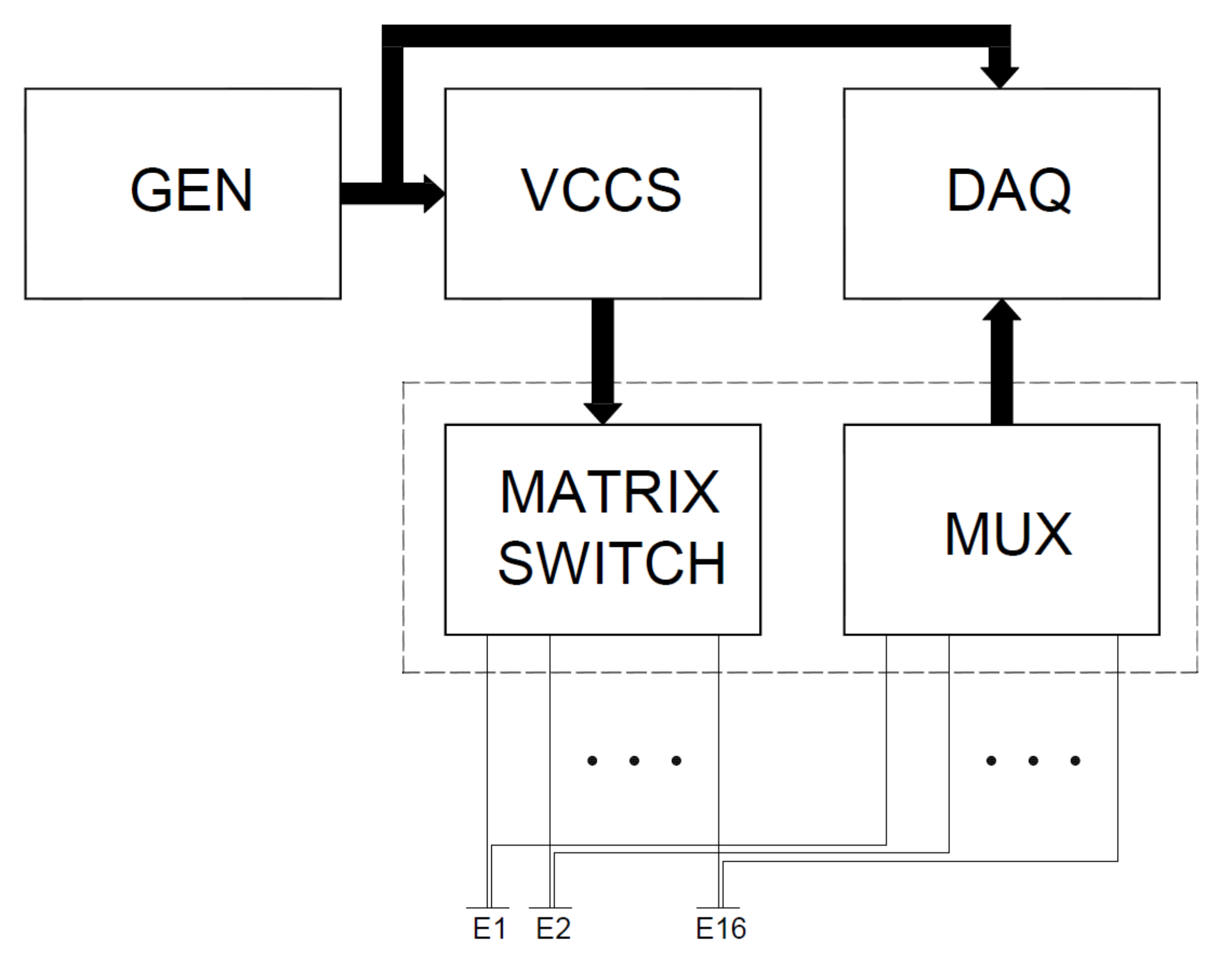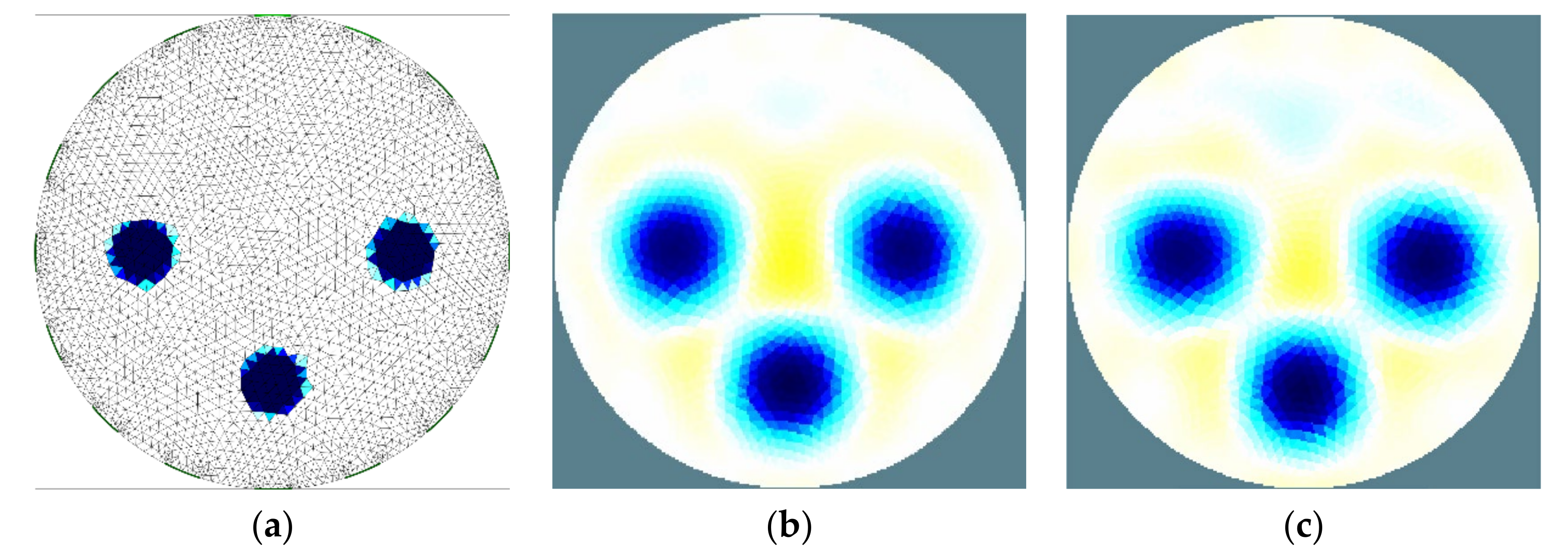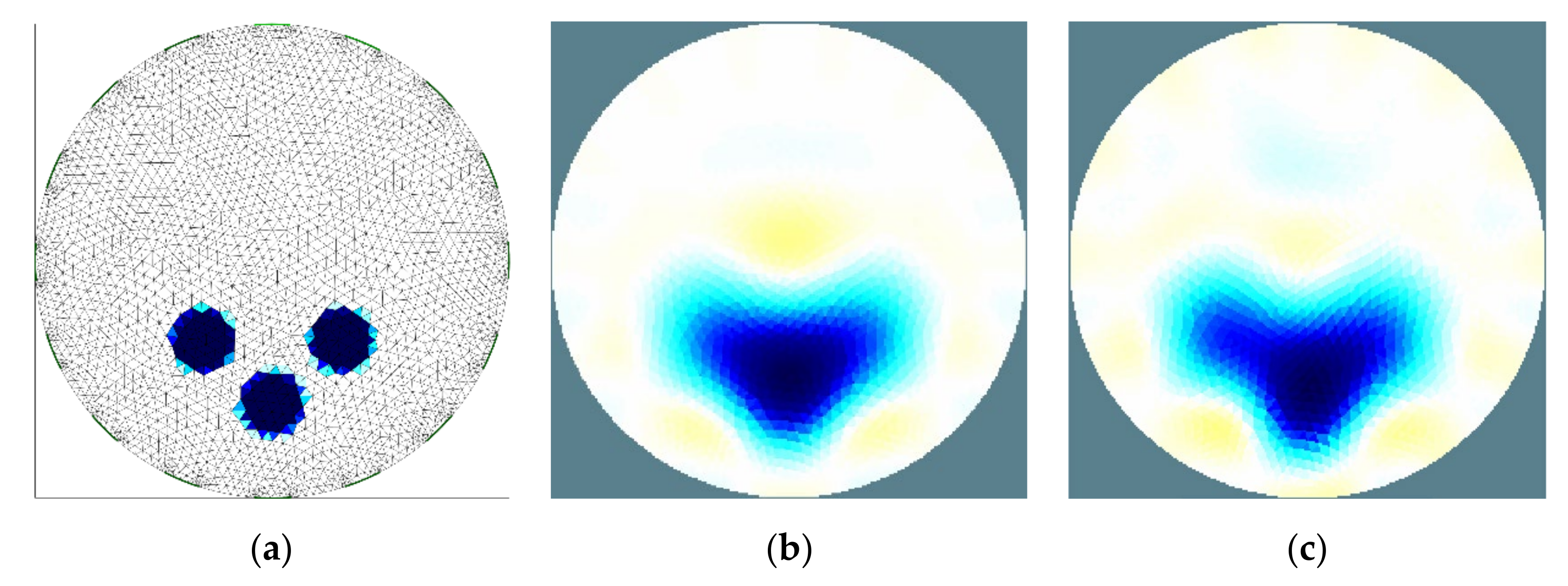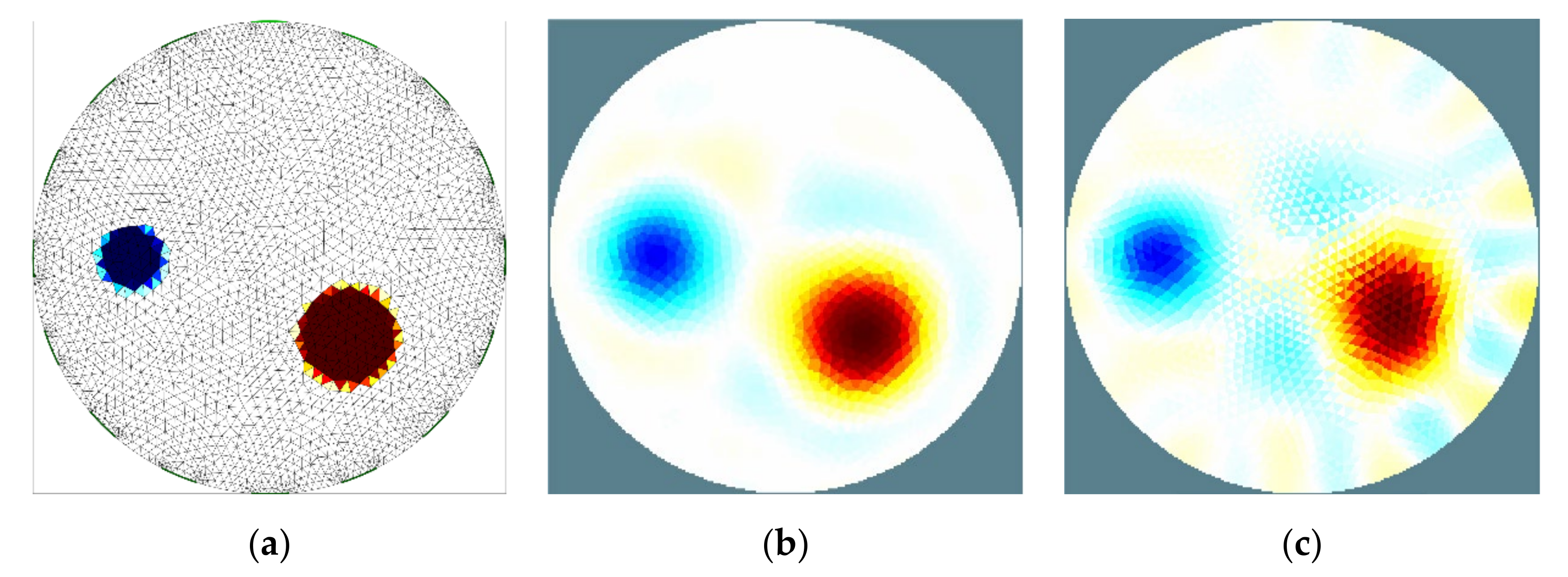Multifrequency Impedance Tomography System for Research on Environmental and Thermal Processes
Abstract
1. Introduction
- Magnetic Induction Tomography (MIT)—may be used to determine the permeability distribution inside the examined object [7].
2. Materials and Methods
2.1. The Principle of the EIT Imaging
2.2. The EIT System Build
- arbitrary waveform signal generator (Keysight 33511B),
- switching device (Keysight 34972A),
- DAQ card (NI PCIe-6351).
2.3. Data Processing and Image Reconstruction
2.4. Description of the Validation Method
- correct detection of the material inside the area of the sensor,
- distinguishing between conductive and non-conductive material,
- detection of material characterized by frequency-dependent conductivity,
- visualization of the temporal progress of the selected process.
3. Results and Discussion
3.1. Comparison of Selected Algorithms for the Image Reconstruction
3.2. Analysis of the Object Detection
3.3. Distinguishability between Conductive and Non-Conductive Objects
3.4. Multifrequency Detection of the Biological Material
3.5. Visualization of the Pollutant Migration in the Sand Bed
4. Conclusions
Funding
Institutional Review Board Statement
Informed Consent Statement
Data Availability Statement
Conflicts of Interest
References
- Wajman, R. Computer methods for non-invasive measurement and control of two-phase flows: A review study. Inf. Technol. Control. 2019, 48, 464–486. [Google Scholar] [CrossRef]
- Tapp, H.; Peyton, A.; Kemsley, E.; Wilson, R. Chemical engineering applications of electrical process tomography. Sensors Actuators B Chem. 2003, 92, 17–24. [Google Scholar] [CrossRef]
- Holder, D.S. Electrical Impedance Tomography. In Methods, History and Application; Institute of Physics Publishing: Bristol, UK, 2005. [Google Scholar]
- Padilha Leitzke, J.P.; Zangl, H. A Review on Electrical Impedance Tomography Spectroscopy. Sensors 2020, 20, 5160. [Google Scholar] [CrossRef] [PubMed]
- Zhang, W.; Wang, C.; Yang, W.; Wang, C.-H. Application of electrical capacitance tomography in particulate process measurement—A review. Adv. Powder Technol. 2014, 25, 174–188. [Google Scholar] [CrossRef]
- Porzuczek, J. Applications of the electrical capacitance tomography for research on phenomena occurring in the fluidized bed reactors. Chem. Process Eng. 2014, 35, 397–408. [Google Scholar] [CrossRef]
- Peyton, A.J.; Yu, Z.Z.; Lyon, G.; Al-Zeibak, S.; Ferreira, J.; Velez, J.; Linhares, F.; Borges, A.R.; Xiong, H.L.; Saunders, N.H.; et al. Overview of electromagnetic inductance tomography: Description of three different systems. Meas. Sci. Technol. 1996, 73, 261–271. [Google Scholar] [CrossRef]
- Wang, M. Industrial Tomography—Systems and Applications; Woodhead Publishing: Sawston, UK, 2015. [Google Scholar]
- Hoyle, B.S.; Nahavi, M. Spectro-tomography—An electrical sensing method for integrated estimation of component identification and distribution mapping in industrial processes. In Proceedings of the IEEE Sensors 2008 Conference, Lecce, Italy, 26–29 October 2008; pp. 807–810. [Google Scholar]
- Nahvi, M.; Hoyle, B.S. Wideband electrical impedance tomography. Meas. Sci. Technol. 2008, 19, 1–9. [Google Scholar] [CrossRef]
- Hoyle, B.S. Spectro-tomography. In Industrial Tomography—Systems and Applications; Wang, M., Ed.; Woodhead Publishing: Sawston, UK, 2015; pp. 263–284. [Google Scholar]
- Smyl, D. Electrical tomography for characterizing transport properties in cement-based materials: A review. Constr. Build. Mater. 2020, 244, 118299. [Google Scholar] [CrossRef]
- Rymarczyk, T.; Kłosowski, G.; Hoła, A.; Hoła, J.; Sikora, J.; Tchórzewski, P.; Skowron, Ł. Historical Buildings Dampness Analysis Using Electrical Tomography and Machine Learning Algorithms. Energies 2021, 14, 1307. [Google Scholar] [CrossRef]
- Porzuczek, J. Assessment of the Spatial Distribution of Moisture Content in Granular Material Using Electrical Impedance Tomography. Sensors 2019, 19, 2807. [Google Scholar] [CrossRef] [PubMed]
- Kemna, A.; Binley, A.; Ramirez, A.; Daily, W. Complex resistivity tomography for environmental applications. Chem. Eng. J. 2000, 77, 11–18. [Google Scholar] [CrossRef]
- Sapuan, I.; Yasin, M.; Ain, K.; Apsari, R. Anomaly Detection Using Electric Impedance Tomography Based on Real and Imaginary Images. Sensors 2020, 20, 1907. [Google Scholar] [CrossRef] [PubMed]
- Wang, F.; Marashdeh, Q.; Fan, L.-S.; Warsito, W. Electrical Capacitance Volume Tomography: Design and Applications. Sensors 2010, 10, 1890–1917. [Google Scholar] [CrossRef] [PubMed]
- Mosorov, V.; Rybak, G.; Sankowski, D. Plug Regime Flow Velocity Measurement Problem Based on Correlability Notion and Twin Plane Electrical Capacitance Tomography: Use Case. Sensors 2021, 21, 2189. [Google Scholar] [CrossRef]
- Mallach, M.; Gevers, M.; Gebhardt, P.; Musch, T. Fast and Precise Soft-Field Electromagnetic Tomography Systems for Multiphase Flow Imaging. Energies 2018, 11, 1199. [Google Scholar] [CrossRef]
- Bennett, M.A.; Williams, R.A. Monitoring the operation of an oil/water separator using impedance tomography. Miner. Eng. 2004, 17, 605–614. [Google Scholar] [CrossRef]
- Tarabi, N.; Mousazadeh, H.; Jafari, A.; Taghizadeh-Tameh, J.; Kiapey, A. Developing and evaluation of an electrical impedance tomography system for measuring solid volumetric concentration in dredging scale. Flow Meas. Instrum. 2021, 80, 101986. [Google Scholar] [CrossRef]
- Stanley, S. Tomographic imaging during reactive precipitation in a stirred vessel: Mixing with chemical reaction. Chem. Eng. Sci. 2006, 61, 7850–7863. [Google Scholar] [CrossRef]
- Wang, M.; Ramskill, N.P.; Barns, S.; Raynel, G.; Qiu, C.; Rayner, C.M. A feasible process tomography and spectroscopy measurement system to determine carbon dioxide absorption. Flow Meas. Instrum. 2012, 31, 77–85. [Google Scholar] [CrossRef]
- Asami, K. Characterization of heterogeneous systems by dielectric spectroscopy. Prog. Polym. Sci. 2002, 27, 1617–1659. [Google Scholar] [CrossRef]
- Sciospec Scientific Instruments. Available online: https://www.sciospec.com/ (accessed on 23 July 2021).
- Industrial Tomography Systems. Available online: https://www.itoms.com/ (accessed on 23 July 2021).
- Process Tomography Limited. Available online: http://www.tomography.com/ (accessed on 23 July 2021).
- Boone, K.; Barber, D.; Brown, B. Imaging with electricity: Report of the European Concerted Action on Impedance Tomography. J. Med. Eng. Technol. 1997, 21. [Google Scholar] [CrossRef] [PubMed]
- Zhu, Q.; Lionheart, W.; Lidgey, F.; McLeod, C.; Paulson, K.; Pidcock, M. An adaptive current tomograph using voltage sources. IEEE Trans. Biomed. Eng. 1993, 40, 163–168. [Google Scholar] [CrossRef]
- Hartov, A.; Mazzarese, R.A.; Reiss, F.R.; Kerner, T.E.; Osterman, K.S.; Williams, D.B.; Paulsen, K.D. A multichannel continuously selectable multifrequency electrical impedance spectroscopy measurement system. IEEE Trans. Biomed. Eng. 2000, 47, 49–58. [Google Scholar] [CrossRef]
- Oh, T.I.; Koo, H.; Lee, K.H.; Kim, S.M.; Lee, J.; Kim, S.W.; Seo, J.K.; Woo, E.J. Validation of a multi-frequency electrical impedance tomography (mfEIT) system KHU Mark1: Imedance spectroscopy and time-difference imaging. Physiol. Meas. 2008, 29, 295–307. [Google Scholar] [CrossRef]
- Oh, T.I.; Wi, H.; Kim, D.Y.; Yoo, P.J.; Woo, E.J. A fully parallel multi-frequency EIT system with flexible electrode configuration: KHU Mark2. Physiol. Meas. 2011, 32, 835–849. [Google Scholar] [CrossRef] [PubMed]
- Tan, C.; Liu, S.; Jia, J.; Dong, F. A Wideband Electrical Impedance Tomography System Based on Sensitive Bioimpedance Spectrum Bandwidth. IEEE Trans. Instrum. Meas. 2020, 69, 144–154. [Google Scholar] [CrossRef]
- Darnajou, M.; Dupré, A.; Dang, C.; Ricciardi, G.; Bourennane, S.; Bellis, C. On the Implementation of Simultaneous Multi-Frequency Excitations and Measurements for Electrical Impedance Tomography. Sensors 2019, 24, 3679. [Google Scholar] [CrossRef]
- Singh, G.; Anand, S.; Lall, B.; Srivastava, A.; Singh, V. A Low-Cost Portable Wireless Multi-frequency Electrical Impedance Tomography System. Arab. J. Sci. Eng. 2019, 44, 2305–2320. [Google Scholar] [CrossRef]
- Baidillah, M.R.; Iman, A.-A.S.; Sun, Y.; Takei, M. Electrical Impedance Spectro-Tomography Based on Dielectric Relaxation Model. IEEE Sens. J. 2017, 17, 8251–8262. [Google Scholar] [CrossRef]
- Jordana, J.; Gasulla, M.; Pallàs-Areny, R. Electrical resistance tomography to detect leaks from buried pipes. Meas. Sci. Technol. 2001, 12, 1061–1068. [Google Scholar] [CrossRef]
- Cheney, M.; Isaacson, D.; Newell, J.C.; Simske, S.; Goble, J. NOSER: An algorithm for solving the inverse conductivity problem. Int. J. Imaging Syst. Technol. 1990, 2, 66–75. [Google Scholar] [CrossRef]
- Khan, T.A.; Ling, S.H. Review on Electrical Impedance Tomography: Artificial Intelligence Methods and its Applications. Algorithms 2019, 12, 88. [Google Scholar] [CrossRef]
- Adler, A.; Lionheart, W. Uses and abuses of EIDORS: An extensible software base for EIT. Physiol. Meas. 2006, 27, S25–S42. [Google Scholar] [CrossRef] [PubMed]
- Netgen. Available online: https://ngsolve.org/ (accessed on 15 July 2021).
- Keysight 33511B Arbitrary Waveform Signal Generator Specification. Available online: https://www.keysight.com/zz/en/support/33511B/waveform-generator-20-mhz-1-channel-arb.html (accessed on 12 July 2021).
- Keysight 34972A Switching Device Specification. Available online: https://www.keysight.com/zz/en/product/34972A/lxi-data-acquisition-data-logger-switch-unit.html (accessed on 12 July 2021).
- NI 6351 Device Specification. Available online: http://www.ni.com/pdf/manuals/374591d.pdf (accessed on 12 July 2021).
- Principles of Lock-in Detection. Available online: https://www.zhinst.com/europe/en/resources/principles-of-lock-in-detection (accessed on 12 July 2021).
- AN-1515 A Comprehensive Study of the Howland Current Pump. Application Report. Available online: https://www.ti.com/lit/an/snoa474a/snoa474a.pdf?ts=1627236278517&ref_url=https%253A%252F%252Fwww.ti.com%252Fproduct%252FLM6132 (accessed on 22 July 2021).
- LT1222 Operational Amplifier Datasheet. Available online: https://www.analog.com/en/products/lt1222.html (accessed on 22 July 2021).
- Ye, B.; Chen, F.; Li, M. The Digital Lock-in Amplifier for Detecting the Power Traveling Wave Signal. Int. J. Signal Process. Image Process. Pattern Recognit. 2015, 8, 361–374. [Google Scholar] [CrossRef]
- Hayden, R.I.; Moyse, C.A.; Calder, F.W.; Crawford, D.P.; Fensom, D.S. Electrical Impedance Studies on Potato and Alfalfa Tissue. J. Exp. Bot. 1969, 20, 177–200. [Google Scholar] [CrossRef]
- Marra, F. Impact of freezing rate on electrical conductivity of produce. SpringerPlus 2013, 2, 1–5. [Google Scholar] [CrossRef][Green Version]









Publisher’s Note: MDPI stays neutral with regard to jurisdictional claims in published maps and institutional affiliations. |
© 2021 by the author. Licensee MDPI, Basel, Switzerland. This article is an open access article distributed under the terms and conditions of the Creative Commons Attribution (CC BY) license (https://creativecommons.org/licenses/by/4.0/).
Share and Cite
Porzuczek, J. Multifrequency Impedance Tomography System for Research on Environmental and Thermal Processes. Energies 2021, 14, 6366. https://doi.org/10.3390/en14196366
Porzuczek J. Multifrequency Impedance Tomography System for Research on Environmental and Thermal Processes. Energies. 2021; 14(19):6366. https://doi.org/10.3390/en14196366
Chicago/Turabian StylePorzuczek, Jan. 2021. "Multifrequency Impedance Tomography System for Research on Environmental and Thermal Processes" Energies 14, no. 19: 6366. https://doi.org/10.3390/en14196366
APA StylePorzuczek, J. (2021). Multifrequency Impedance Tomography System for Research on Environmental and Thermal Processes. Energies, 14(19), 6366. https://doi.org/10.3390/en14196366





